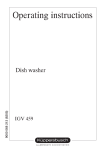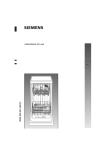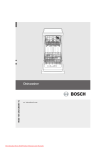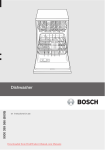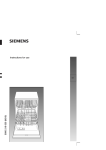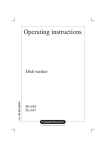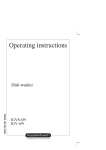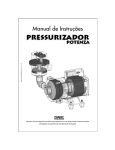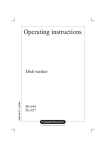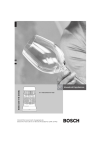Download BALAY 3VN641ID Specifications
Transcript
9000 041 066 en en Index Safety instructions . . . . . . . . . Getting to know your appliance Water softener . . . . . . . . . . . . Filling the special salt container Filling the rinse-aid container Unsuitable dishes . . . . . . . . . Arranging crockery, glasses, etc. in the dishwasher . . . . . . 4 5 6 7 8 9 10 Detergents . . . . . . . . . . . . . . . Programme overview . . . . . . Washing dishes . . . . . . . . . . . Maintenance and care . . . . . . Fault finding . . . . . . . . . . . . . . Customer Service . . . . . . . . . Important information . . . . . . . Installation . . . . . . . . . . . . . . . . 12 14 15 16 18 20 21 21 en Safety instructions Delivery Immediately check the packaging and dishwasher for any damage which may have been caused in transit. Do not use a damaged appliance, but consult your supplier. Please dispose of packaging material properly. The corrugated cardboard consists mainly of waste paper. The polystyrene moulded parts have been foamed without any CFCs. The polyethylene film (PE) consists partly of secondary raw material. The wooden frames (if fitted) are made of residual wood and are untreated. The hoops (if fitted) consist of polypropylene (PP). Installation Install and connect the appliance according to the installation and assembly instructions. The dishwasher must NOT be connected to the power supply during installation. Ensure that the protective conductor system of the domestic electricity supply has been installed correctly. Electrical connection conditions must correspond with the specifications on the rating plate of the dishwasher. Built-under and built-in appliances should always be installed under a continuous work surface which is attached to the adjacent cupboards, in order to ensure that the appliance is entirely stable. After the appliance has been installed, the mains plug should still be easily accessible. 4 Not on all models: The plastic housing on the water input contains an electrically operated valve. The connecting wires are inside the inlet hose. Do not cut through this hose and do not immerse the plastic housing in water. Warning For safety reasons, if the appliance is not fitted in a recess, thereby making a side wall accessible, the door hinge area should be covered at the side. (Risk of injury) Covers are available as optional accessories from customer services or specialist stores. During normal use Warning Knives and other utensils with sharp points must be loaded in the basket with their points down or in a horizontal position. Use the dishwasher solely in a domestic environment and for its designated purpose: washing household tableware and other utensils. Do not place any heavy objects or stand on the door when it is open. The appliance could tip forward. The water inside the dishwasher is not suitable for drinking. Do not use solvents of any kind inside your dishwasher. They could cause an explosion. Open the door very carefully if the dishwasher is operating. There is a risk of water squirting out. If your family includes children Do not permit small children to play with or operate the dishwasher. Keep children away from detergents and rinse-aids. Keep small children away from the open door of the dishwasher. There could still be some detergent left inside. en Child lock * * on applicable models Please refer to the drawings enclosed in the envelope 40 Engaging the child lock 41 Opening the door with the child lock engaged 42 Disengaging the child lock If a fault occurs Repairs or other work on the dishwasher should only be carried out by a qualified specialist. The dishwasher must be disconnected from the electricity supply before any repairs or other work are started. Pull the mains plug out of the wall socket or switch off at the fuse box. Grasp the plug to remove it from the socket; do not tug on the cable. Turn the water off at the tap. When disposing of old appliances Appliances that have reached the end of their service life should be rendered inoperable in order to exclude the possibility of subsequent accidents. Pull the mains plug out of the wall socket, cut through the connecting cable and disable the door lock. Take the appliance to a designated waste disposal centre. Warning Children could get locked in the appliance (risk of suffocation) or get stuck in other positions. Therefore: Remove the mains plug, cut the mains wire and set aside. Damage the door lock so that the door can no longer be closed. Getting to know your appliance Diagrams of the control panel and the interior of the appliance can be found in the envelope at the front. Individual positions are referred to in the text. Control panel 1 2 3 4 5 6 Main switch Door handle PROGRAMME END indicator LOW SALT indicator * LOW RINSE-AID indicator * Programme buttons * on applicable models Appliance interior 20 21 22 23 24 25 26 27 28 29 30 31 Upper basket with 2-tiered cup rack Additional cutlery basket for the top basket * Upper spray arm Lower spray arm Container for special salt with level indicator * Filters Cutlery basket Lower basket Locking mechanism Container for rinse-aid, with level indicator Detergent compartment Nameplate * not on all models You will need to purchase the following before using the dishwasher for the first time: – special salt for use in dishwashers – detergent – rinse-aid Only use products, which are suitable for dishwashers. 5 en Water softener In order to rinse dishes and glasses satisfactorily, the dishwasher requires soft water, i.e. containing little or no lime, otherwise water stains will be left behind on crockery and glasses, etc. If the tap water exceeds a certain level of hardness, it must be softened, i.e. decalcified, so that it can be used in the dishwasher. This is achieved by adding a special salt to the water softener inside the dishwasher. The water softener, that is the required amount of salt, is set up according to how hard the tap water is. Setting up the water softener Determine the level of hardness of your tap water. Your local water company or service agent can help you with this. Identify setting from the following water hardness table. Hold down the programme button B and switch on the main switch 1 , then release the buttons. The display 4 flashes and buttons A and B illuminate. (Hardness value 2 was set at the factory). To change the setting: Press programme button B . Each depression of the button increases the set value by one (0–3). If buttons A , B and C illuminate, the maximum hardness value has been reached. If the hardness value is now increased again, the illuminated buttons go out and the hardness value is set to 0 (no buttons illuminated). Switch off the mains switch 1 . The set value is stored in the appliance. Approx. 4 litres of water are required for regenerating the water softening system. The overall water consumption per load can therefore be increased by between 0 and a maximum of 4 litres according to the water hardness setting. Water hardness table _dh _fH _Clarke mmol/ l B Reset 0–6 0–11 0–8 7–16 12–29 9–20 1,2–2,9 1 17–21 30–37 21–26 3,0–3,7 2 22–35 38–60 27–44 3,8–6,2 3 6 0–1,1 A 0 C en Filling the special salt container How the salt works While washing is taking place, salt is automatically rinsed out of the salt container into the water softener where it dissolves the lime in the water. The dissolved lime is pumped out of the dishwasher. The water softening system is then ready for the next load. This process of regeneration can only function when the salt is dissolved in water. Unscrew the lid on the salt container 24 . Before you use the dishwasher for the first time, pour approx. 1 litre of water into the salt container. Use the enclosed salt filler. Refill with salt (do not use edible salt) until the salt dispenser is full (max. 1.5 kg). When the salt dispenser is being refilled, water is displaced and drains away. Therefore always refill the salt dispenser immediately before switching on the dishwasher (to prevent corrosion). As a result, the overflowing salt solution will be immediately diluted and rinsed out. Then remove salt residue from the filler area and screw on the dispenser cover, ensuring that it is not fitted askew. The LOW SALT indicator 4 on the front panel will light up initially but will extinguish again after a short period when the salt solution has become sufficiently concentrated. If the switch is set to ”0”, it is not necessary to add any salt, as none is consumed while the dishwasher is operating. If the switch is set between ”1” and ”3”, then salt must be added. Do not pour detergent into the container for special salt. This would destroy the water softener. LOW SALT indicator * on applicable models Salt should be added as soon as the LOW SALT indicator 4 in the fascia panel illuminates. For models that do not have an indicator in the fascia panel, salt should be added as soon as the coloured dot in the lid on the salt container 24 is no longer visible. 7 en Filling the rinse-aid container The purpose of a rinse-aid is to prevent the formation of water marks on tableware and utensils, and to ensure that glasses are clean and sparkling. The rinse-aid is consumed during the washing process. Fold back the lid on the rinse-aid container 29 . on To open the lid, press the mark the rinse-aid lid and simultaneously lift . the lid off the lug Adjusting the amount of rinse-aid The amount of rinse-aid added to the water can be varied by adjusting the stepless control. The rinse-aid control has been set to ”4” in the factory. Do not alter the setting of the rinse-aid control unless streaks (turn knob towards ”–”) or water marks (turn knob towards ”+”) are left on the dishes. 29 rinse–aid control Pour the rinse-aid into the filler hole until the level indicator turns dark. Close the lid, ensuring that you hear it snap closed. LOW RINSE–AID indicator As long as the LOW RINSE-AID indicator on the front panel 5 or on the dispenser 29 is dark, there is sufficient rinse-aid in the dishwasher. Note Use only rinse aid for domestic dishwashers. Spilt rinse aid may result in excessive foam formation in the next rinse cycle. Therefore, remove any spilt rinse aid with a cloth. 8 LOW RINSE-AID indicator en Unsuitable dishes You should not clean the following items in your dishwasher: Cutlery and dishes made of wood. They will leach out and become unsightly; the utilised adhesives are also not suitable for the dishwasher temperatures. Delicate décor glasses, craft dishes and vases, special antique or irreplaceable dishes. These décor items are not dishwasher-safe. Plastic parts, copper and tin dishes sensitive to hot water are not suitable either. Overglazed patterns, aluminium and silver parts tend to become discoloured and fade during the rinsing cycle. Even some types of glass (e.g. crystal glass objects) may become cloudy after many rinse cycles. Completely absorbent materials, such as sponges and cloths must not be cleaned in the dishwasher either. Recommendation: In future buy only dishes which are identified as dishwasher-safe. Damage to glassware and other dishes Possible causes: type of glass or manufacturing process chemical composition of detergent water temperature and duration of dishwasher programme. Suggested remedy: Use glassware or porcelain dishes that have been marked ’dishwasher–proof’ by the manufacturer. Use a mild detergent that is described as ’kind to dishes’. If necessary, seek further information from detergent manufacturers. Select a programme with as low a temperature and as short a duration as possible. To prevent damage, take glass and cutlery out of the dishwasher as soon as possible after the programme has ended. Note Dishes which are soiled with ash, wax, lubricating grease or ink must not be cleaned in the dishwasher. 9 en Arranging crockery, glasses, etc. in the dishwasher Pots and pans Lower basket 27 Loading the dishwasher Scrape off any large amounts of left-over food. It is not necessary to rinse the dishes under running water. Place objects in the dishwasher in such a way that items such as cups, glasses, pots/pans, etc. are stood upside down, curved items, or those with recesses, should be at a slant so that water can run off, they are stacked securely and cannot tip over, they do not prevent the spray arms from rotating while washing takes place. Very small items should not be washed in the dishwasher as they could easily fall out of the baskets. Removing the dishes To prevent water dripping from the top basket onto the dishes in the lower basket, we recommend that you empty the lower basket first and then the top basket. Cups and glasses Upper basket 20 Cutlery Cutlery should always be inserted in random order with the handles pointing downwards (take care with knife blades!). This enables the jet of water to reach the individual items more easily. To prevent the risk of injury, place long and pointed implements and knives on the shelf (some models) or knife shelf (available as an accessory). Folding spikes * * on applicable models To improve stacking of pots and pans, the spikes can be folded down. * on applicable models 10 en Spray head for baking sheets * Adjusting position of basket * * on applicable models Please refer to the drawings enclosed in the envelope Large baking sheets or grids can be cleaned with the aid of the special spray head. Remove the top basket and attach the spray head as shown in the drawing. Arrange the baking sheets as illustrated, so that the jet of water can reach all parts of them (max. 2 baking sheets and 2 grids). * not on all models Shelf * * not on all models Lean tall glasses and those with long stems against the shelf – not against other items to be washed. The top basket can be inserted on either its upper or lower rollers, according to requirement. This enables more height to be gained for bigger dishes in either the top or bottom basket. Place glasses, cups and small bowls on the additional cup rack. The additional cup rack can be swivelled in or out as required. 11 en Detergents Information about detergents You can use any brand of liquid or powder detergent, as well as tablets, that have been specifically designed for use in domestic dishwashers. (Do not use normal washing-up liquid!) Detergent compartment with measuring marks The side of the detergent compartment is marked with lines to help you determine how much powder to add. The capacity of the detergent container is 15 ml up to the bottom line and 25 ml up to the middle line. When the compartment is full it contains 40 ml. Nowadays there are three types of dishwasher detergent available: 1. those containing phosphates and chlorine, 2. those containing phosphates but no chlorine, 3. those containing neither phosphates nor chlorine. When a phosphate-free detergent is used in conjunction with hard water, there is a greater possibility that white marks will be left behind on crockery and glasses, etc. These can be avoided by pouring an increased amount of detergent into the dispenser. Chlorine-free detergents have a reduced bleaching effect. This can mean that tea stains are not completely removed or plastic items become discoloured. This can be resolved by: – selecting a higher temperature programme, or – increasing the amount of detergent, or – using a detergent that contains chlorine. Check the label on the detergent packaging to determine whether a particular product is suitable for use with silverware. If you have any further questions, we recommend that you contact the customer advice departments of the various detergent manufacturers. 12 40 ml 25 ml 15 ml Important If the lid on the detergent compartment is closed, press the release lever to open the flap. Adding detergent Tip detergent powder into the corresponding compartment 30 . Please observe the manufacturer’s instructions printed on the detergent packaging when determining the correct dosage. Due to the different solvency properties of the detergent tablets supplied by various manufacturers, the cleaning efficiency of the detergent may not be fully utilised by short programmes. It is recommended to use washing powder for these programmes. When you select the INTENSIVE programme, tip an extra 10–15 ml of detergent onto the inside surface of the door. en Reduce costs! If your dishes are only moderately dirty, you may be able to use less detergent than recommended. Close the lid on the detergent compartment. Press down the lid (1) until it clicks shut (2). CAUTION IMPORTANT NOTE ON THE USE OF COMBINED CLEANING PRODUCTS Please note the following when using ”combined cleaning products” which eliminate the need for a rinsing agent or salt, for example: Some products with a built-in rinsing agent are only used to their full effect in certain programmes. This type of product does not generally produce the desired effect with automatic programmes. If you are using detergent in tablet form, read the manufacturer’s recommendations on the packaging in order to determine where the tablets should be placed inside the dishwasher (e.g. in cutlery basket, detergent compartment, etc.). Make sure that the lid on the detergent compartment is closed, even if you are using tablets. Products which eliminate the need for regeneration salt can only be used within a certain water hardness range. If you wish to use these combined products, please read the instructions carefully and heed any notes on the packaging. Contact the manufacturer of the cleaning agent if you have any questions, particularly if: the crockery is very wet once the programme has finished. limescale deposits are formed. Any problems which arise as a direct result of the use of these products are not covered by our warranty. 13 en Programme overview This overview lists the max. possible number of programmes. The programmes supplied with your appliance are indicated on the fascia. Type of crockery e.g.china, Nonpots/pans, delicate cutlery, glasses, etc. Type of food remains Mixed Soups, casseroles, sauces, potatoes, pasta, rice, eggs, roast or fried food Soups, potatoes, pasta, rice, eggs, roast or fried food Coffee, cakes, milk, sausage, cold drinks, salads Amount of food remains a lot a little very little Condition of food remains stuck on hard loosely attached Wash programme Intesive 70° Normal 65° Eco 50° Programme sequence Pre-rinse 50° Pre-rinse Pre-rinse Wash 70° Wash 65° First rinse First rinse Wash 50° Main rinse Main rinse Second rinse Second rinse Rinse-aid 65° Rinse-aid 55° Third rinse Rinse-aid 70° Drying Rinse-aid 70° Drying Drying 14 Rinse off if the dishes have been stacked for several days in the dishwasher prior to washing. Quick 35° Pre-rinse Pre-rinse Wash 35° en Washing dishes Programme selection The most appropriate programme can be identified by comparing the type of crockery, cutlery, etc., as well as the amount and condition of food remains, with the details contained in the programme overview. Switching the dishwasher ON Set main switch 1 to ON. Indicators light up according to the last programme that was selected. This same programme will run again if no other programme button 6 is pressed. The programme starts automatically. End of programme The corresponding programme sequence, duration and consumption details are shown in the bottom half of the overview. For example: Use the “Normal” programme for dishes and utensils which have plenty of food remains stuck on hard. Reduce costs! If only a small number of dishes have been loaded into the dishwasher, selecting a programme that operates at the next lowest temperature will usually suffice. Programme data The stated programme data are based on standard operating conditions. The values can vary considerably according to: different amounts of dishes temperature of mains water supply pressure of mains water supply ambient temperature fluctuations in mains voltage machine-related factors (e.g. temperature, water volume, ...). Energy and water consumption is reduced by up to 1/4 when dishes are washed in the upper basket only. Water consumption values are based on a water hardness setting of 2. The programme has come to an end when the PROGRAMME END indicator 3 and the indicator for the selected programme are both lit up. Switching the dishwasher OFF Several minutes after the programme has ended: Set the main switch 1 to OFF. Turn the water tap off. (Does not apply when Aqua-Stop unit has been fitted) Remove dishes, etc. when they have cooled down. Interrupting the programme Set main switch 1 to OFF. Indicator lights extinguish. The programme is retained in the dishwasher memory. If the hot water was switched ON or the appliance has already heated up and then the appliance door opened, leave the door ajar for several minutes and then close. Otherwise, the appliance door may fly open due to expansion. In order to continue with the stored programme, set the main switch to ON again. 15 en Cancel programme (Reset) Only when the master switch is ON. Press the A and C programme buttons simultaneously and hold them pressed for approx. 3 sec. The programme continues for approx. 1 min. The PROGRAMME END indicator and the indicator for the programme that has just been terminated light up. Set main switch 1 to OFF. Close the detergent compartment 30 . To restart the dishwasher, set main switch 1 to ON again and select desired programme. Changing the programme It is possible to change the programme within 2 minutes after you have switched the dishwasher on. Should it be necessary to change the programme after this period, the programme cycle that has already been begun (e.g. washing) will be completed first of all. 16 Maintenance and care You can help prevent faults by checking and maintaining your appliance regularly. This will save time and reduce problems. Therefore you should occasionally examine the inside of your dishwasher. Overall condition of the appliance Check the rinsing compartment for grease and limescale deposits. If you find any deposits: Fill the detergent dispenser with detergent. Start the empty appliance with the programme which has the highest rinsing temperature. Clean the door seal: Wipe the door seal regularly with a damp cloth and remove any deposits. Dishwasher salt Check the LOW SALT indicator 4 24 . Top up with salt, if required. or Rinse-aid Check the LOW RINSE-AID indicator 5 on the front panel or the level indicator on the rinse-aid container 29 . Top up with rinse-aid, if required. en Filters Spray arms The filters 25 prevent large particles of food in the water from reaching the pump. These particles may occasionally block the filters. Lime and remnants of food in the washing water can block the nozzles in the spray arms 22 and 23 and the arm mountings . When the appliance has finished washing, check the filters for particles of food and, if required, clean. After undoing the coarse micro-filter, the filter unit can be removed. Remove any particles of food and rinse the filters under running water. Insert the filter unit and tighten the coarse micro-filter. Inspect the nozzles in the spray arms for blocked holes due to remnants of food. If necessary, pull the lower arm 23 upwards and lift it off. Unscrew the upper spray arm 22 . Clean both spray arms under running water. Refit the spray arms. Ensure that the lower arm has locked into place and the upper one is screwed tight. Coarse/microfilter Spray arms 17 en Fault finding Resolving minor problems yourself Experience has shown that you can resolve most problems that arise during normal daily usage yourself, without having to call out a service engineer. Not only does this save costs, but it also means that the appliance is available for use again that much sooner. The following list of common occurrences and their remedies should help you identify the causes of most problems. Problems ... ... when the appliance is switched on Appliance does not start up Fault with fuse in mains electricity supply. Plug not inserted in wall socket. Appliance door not closed properly. Programme button has not been pressed. Water tap not turned on. Blocked strainer in water intake hose. The strainer is situated in the Aquastop or supply-hose connection. Caution Do not forget that repairs should only be carried out by a qualified specialist. Improper repairs can lead to considerable equipment damage as well as danger to the user. ... with the appliance itself Lower spray arm rotates with difficulty Spray arm is blocked by small items or food remains. Lid in detergent compartment cannot be closed Detergent compartment has been overfilled. Mechanism is clogged with remnants of detergent. Indicator lamps do not extinguish after washing has finished. Indicator lamps do not extinguish after washing has finished Main switch is still set to ON. Remnants of detergent stuck inside dispenser Compartment was damp when it was filled up with detergent. Compartment must be dry before detergent is added. Water remains inside appliance after programme has ended Blockage or kink in drainage hose. Pump is jammed. Filters are blocked. The programme is still running. Wait for the programme to end (programme-end display will illuminate). Perform “Reset” function. 18 en ... during washing Unusual amount of foam is created Normal washing up liquid has been poured into the rinse-aid container. Remove any spilled rinse aid with a cloth as it could otherwise lead to excessive foaming during the next washing cycle. Appliance stops suddenly while washing is taking place Cut in electricity supply to appliance. Water supply has been interrupted. Knocking sound can be heard while washing is taking place A spray arm is knocking against the dishes inside the appliance. Rattling sound can be heard while washing is taking place Crockery has not been stacked properly inside the appliance. Knocking sound coming from inlet valves This is caused by the way the water pipes have been laid and it has no effect upon the way the appliance functions. There is no remedy for this. ... with the dishes, cutlery, etc. Remnants of food are stuck to the dishes, cutlery, etc. Dishwasher was not loaded properly. Jets of water could not reach all parts of the dishes, etc. Too many items in the rack. Items in the rack were touching each other. Not enough detergent was added to dispenser. Selected wash programme was not intensive enough. Rotation of spray arm was obstructed by dish, etc. Nozzles in spray arm are blocked by remnants of food. Filters are blocked. Filters have been incorrectly fitted. Waste-water pump is jammed. Plastic items are discoloured Not enough detergent was added to dispenser. Detergent has insufficient bleaching properties. Use a detergent containing a chemical bleaching agent. White stains are left on crockery, glasses have a milky appearance Not enough detergent was added to input compartment. Amount of rinse-aid was set too low. Although water is quite hard, no salt has been put in appliance. Water softener was set too low. Lid on salt container is not screwed tight. If you used a phosphate-free detergent, try a detergent containing phosphates and compare results. 19 en Dishes, cutlery, etc. have not been dried Selected programme did not include drying function. Amount of rinse-aid was set too low. Items were removed from dishwasher too soon. Glasses have a dull appearance Amount of rinse-aid was set too low. Tea stains or traces of lipstick have not been completely removed Detergent does not have a sufficient bleaching effect. Washing temperature was set too low. Traces of rust on cutlery Cutlery is not sufficiently rustproof. Salt content in washing water is too high. Lid on salt container is not screwed tight. Too much salt was spilt while filling container. Glasses become clouded and discoloured; coating cannot be wiped off Unsuitable detergent was used. Glasses are not dishwasher-proof. Smears left behind on glasses and cutlery; glasses have acquired a metallic appearance Amount of rinse-aid set too high. 20 Customer Service Please call your local service agent, if you are not able to resolve any problem yourself. The name of your nearest service agent is shown in the Customer Service address list. When you call, please provide details of the model number (1) and the production (FD) number (2) which are shown on the nameplate on the appliance door. 1 FD 2 Warning Please note that a visit by the customer service technician in the event of a fault or one of the problems previously discussed is not free of charge even during the warranty period. en Important information Notes on waste disposal Old appliances still have some residual value. An environment-friendly method of disposal will ensure that valuable raw materials can be recovered and used again. When an appliance has reached the end of its working life, unplug it from the mains. Cut through the mains cable and dispose of it together with the plug. Destroy the door locking mechanism. This will ensure that children at play cannot become locked inside and are not exposed to the risk of suffocation. Your new appliance was protected by suitable packaging while it was on its way to you. All materials used for this purpose are environment-friendly and can be recycled. Please make a contribution to protecting the environment by disposing of the packaging appropriately. Do not allow children to play with any parts of the packaging. There is a risk of suffocation by the cardboard boxes and the plastic wrapping. Up-to-date information concerning options for disposal can be obtained from your retailer or local municipal administration. General Built-under and integrated appliances which are subsequently installed as free-standing appliances must be secured to prevent them from falling over, e.g. by screwing them to the wall or by installing them under a continuous worktop which is screwed to the adjoining units. For Swiss version only: The appliance can be installed without difficulty between wooden and plastic walls in a kitchen range. If the appliance is not connected via a plug, the installation side must feature an all-pole disconnector with a contact gap of at least 3 mm in order to satisfy the relevant safety regulations. Installation The dishwasher must be connected by a qualified technician to ensure correct operation. The specifications for supply, drainage and connected load must fulfil the required criteria as stated in the following paragraphs or in the installation instructions. Install the appliance in the following sequence: – Check the delivery – Install the appliance – Connect the waste water – Connect the fresh water – Connect the power supply Delivery Your dishwasher was checked at the factory to ensure that it was in perfect working order. This may have left some small water stains in the dishwasher. These will disappear after the first rinse cycle. Installation The required installation dimensions can be found in the installation instructions. Using the height-adjustable feet, adjust the appliance until it is level. Ensure that the appliance is standing firmly. Waste water connection See the installation instructions for the required connection steps. If required, attach a siphon with drainage spigot. Using the enclosed parts, connect the waste water hose to the drainage spigot of the siphon. Ensure that the drainage hose is not kinked, crushed or twisted (ensure that there is no sealing cover which prevents the waster water from flowing away!). 21 en Fresh water connection Transporting the dishwasher Using the enclosed parts, connect the fresh water connection to the tap according to the installation instructions. Ensure that the fresh water connection is not kinked, crushed or twisted. When replacing the appliance, always connect a new water supply hose to the water supply. The old supply hose must not be re-used. Ensure that the fresh water connection is not kinked, crushed or twisted. Water pressure: Minimum 0,5 bar – maximum 10 bar. If the water pressure is higher, install a pressure reducing valve. Flow rate: Minimum of 10 litres per minute. Water temperature: We recommend that you use cold water. If you do use hot water, the temperature should not exceed 60 °C. Drain water from the dishwasher. Secure all loose parts. The appliance should only be transported in an upright position. If the appliance is not kept upright during transport, any water left inside may seep into the control module and cause subsequent errors with programme functions. Electrical connection This appliance should only be connected to a 230/240 V AC source via a properly installed earthed socket. See nameplate 31 for size of required fuse. The socket must be installed close to the dishwasher. If the domestic wiring includes a residualcurrent-operated (FI) circuit-breaker, make sure that it bears the mark, as only this type conforms to the latest regulations Disconnecting the dishwasher Here too, it is important that tasks are carried out in the correct sequence: always unplug the appliance from the mains electricity first of all. Pull plug out of wall socket. Turn off water supply. Disconnect drain and water input hoses. Remove screws in underside of work surface. Detach base board, if fitted. Pull out appliance and carefully withdraw hoses at same time. 22 Protection from freezing temperatures If the appliance is installed in a location where there is a risk of freezing temperatures (e.g. in a holiday home), all water must be completely drained out of the interior. Turn OFF the tap, disconnect the supply hose and allow to drain. Balay (BYSE Electrodomésticos, S.A.) BSH Electrodomésticos España S.A. Avda. de la Industria, 49 50059 Zaragoza (Spain) To contact us directly, use the tel. no or fax no. in the enclosed customer service list.
























